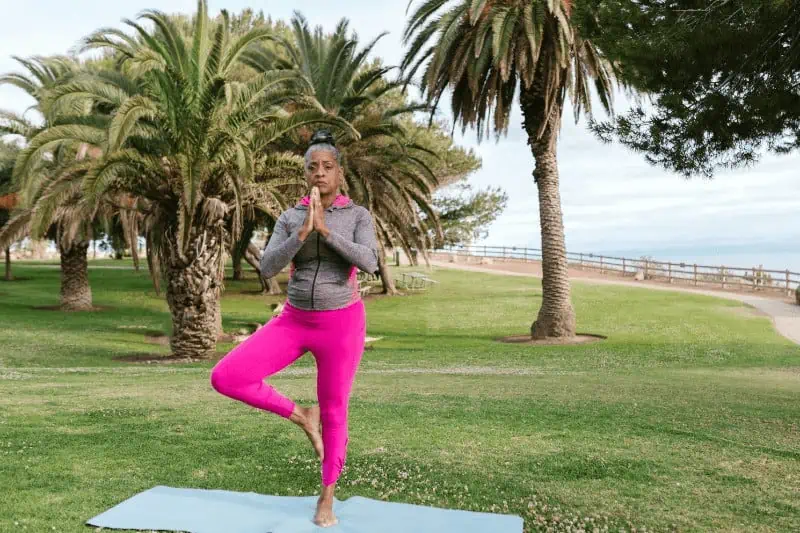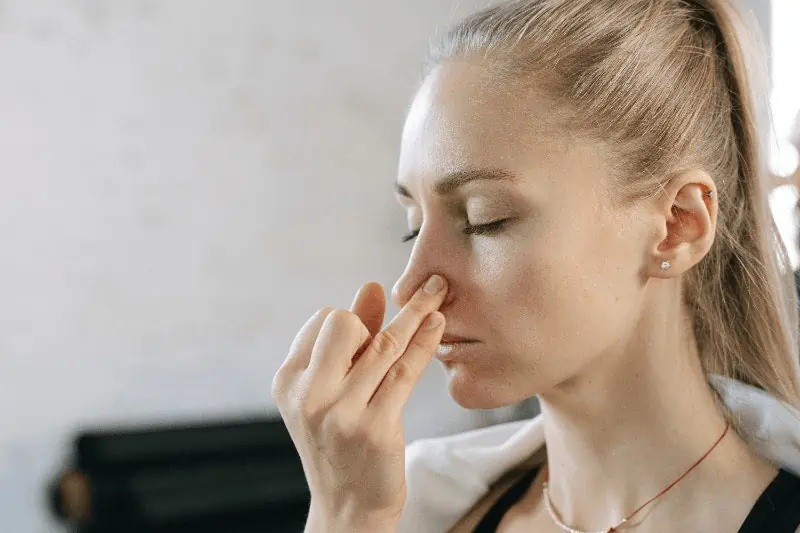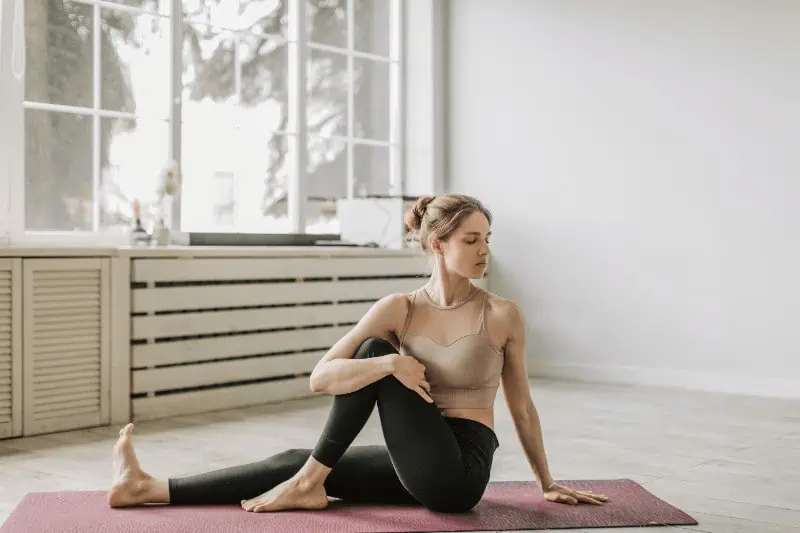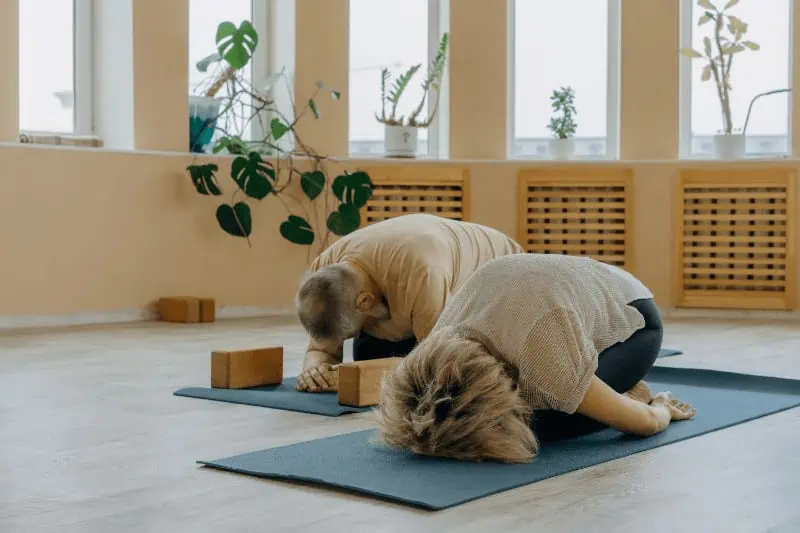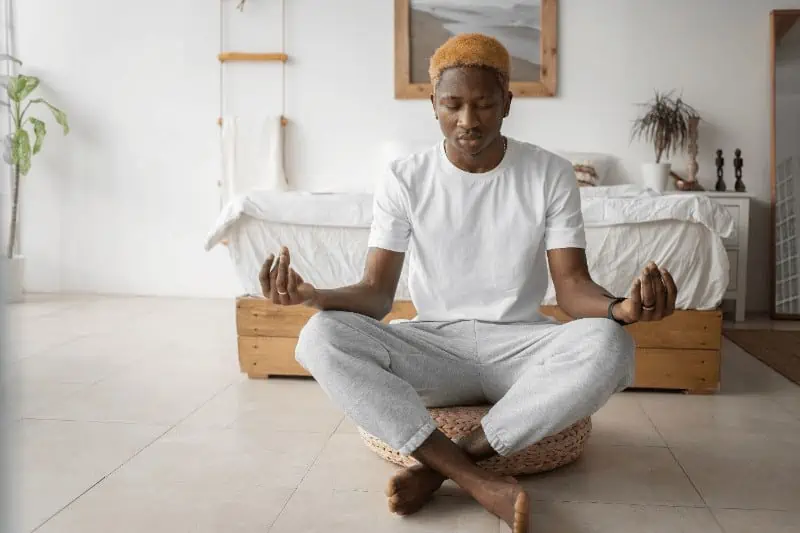Have you ever woken up feeling stiff in the morning? Whether you’re a dedicated yogi or someone looking for relief from joint discomfort, incorporating yoga for joints into your routine can make a world of difference.
The beauty of yoga is its versatility. From gentle stretches to more challenging poses, there are countless ways to target joint health specifically. It’s all about promoting overall mobility and strengthening the muscles that support our body’s most vital connections, all the way down to your bones!
If you’ve been experiencing common aches and pains, this blog is especially for you. We’ll delve into the transformative power of yoga poses and techniques tailored specifically to help manage and even prevent joint pain.
You’ll be amazed to learn how a regular yoga practice can help you maintain mobility, gain flexibility, reduce pain and inflammation, and enhance your overall well-being. So get ready to boost your wellness journey with some mindful movement!
Contents
- 1 Improving Physical Function with Yoga
- 2 Different Types of Yoga for Joints
- 3 Classic Postures and Breathing Exercises for Healthy Joints
- 4 Enhancing Mobility with Unique Yoga Movements
- 5 Ideal Yoga Poses for Arthritis Relief
- 6 Incorporating Yoga for Joints into Your Life
- 7 Maintaining Regular Practice for Joint Pain Relief
- 8 The Role of Seated Meditation in Joint Health
- 9 Tips for a Pain-Free Yoga Practice
- 10 Conclusion: The Impact of Yoga on Joint Health
- 10.1 FAQ 1: Can I do yoga if I have severe joint pain?
- 10.2 FAQ 2: What is the best type of yoga for joints?
- 10.3 FAQ 3: How often should I do yoga for my joints?
- 10.4 FAQ 4: Are there specific poses that help with arthritis relief?
- 10.5 FAQ 5: Is seated meditation important for joint health?
- 10.6 FAQ 6: How can I ensure a pain-free yoga practice?
- 10.7 Was this helpful?
Improving Physical Function with Yoga
Yoga is a highly beneficial physical activity that enhances flexibility, mobility, and muscle strength. Regular participation in a yoga class can significantly improve these areas.
Overall Physical Well-Being
Consistently engaging in a yoga program correlates with improved physical function. Studies reveal that individuals who incorporate regular yoga into their routine experience enhanced mobility, less pain, and better overall physical well-being.
It’s not just about being able to touch your toes; yoga supports all types of movement you might not even be conscious of while completing everyday tasks!
Better Balance and Coordination
Yoga for joints also aids in better balance and coordination. This benefit stems from the focus on body awareness during any given pose. By practicing postures that require balance, you train your nervous system to coordinate your movements more efficiently.
Maintaining balance becomes increasingly important with age to retain mobility and prevent falls. In one study, elderly participants showed significant improvements in balance after just four weeks of following a yoga program.
So you see, the benefits experienced in a yoga class don’t just stop there — they positively impact your life far beyond your yoga mat!
Different Types of Yoga for Joints
Vinyasa Yoga for Mobility
Vinyasa Yoga’s dynamic flow can significantly increase mobility in affected joints. This type of yoga focuses on synchronizing breath with movement, creating a smooth and fluid exercise that enhances joint flexibility.
Hatha Yoga for Strengthening
Hatha Yoga is known for its slower pace. In Hatha Yoga classes, students typically hold postures for several breaths. These gentle movements and longer holds effectively strengthen the muscles around affected joints without causing strain or discomfort.
Yin Yoga for Flexibility
Yin Yoga involves holding deep stretches for extended periods of time to reach into the soft tissues surrounding your joints. In a Yin yoga class, the instructor will direct you into a yoga pose just before your end range of motion, also known as your edge. As you hold the pose for several breaths, you’ll feel your muscles and soft tissues relax. Over time, you’ll likely notice improved joint flexibility.
- Did you know? Many people mistake Yin Yoga for a gentle or restorative practice. While the movements are slow — taking your time entering and exiting each yoga pose — the experience can be intense! Your instructor will likely suggest using props such as a strap, a bolster, or blankets to support you in a Yin Yoga class.
Hot Yoga for Improved Mobility
In hot yoga classes, as you might guess, students practice in a heated room. The higher temperature increases blood flow to muscles and joints, reducing stiffness. The heat also allows muscles to stretch more deeply, increasing your range of motion.
Due to the soothing effects of the warm room, Hot Yoga is a great option for managing Arthritis pain.
Chair Yoga for Limited Mobility
For those with limited mobility, chair yoga is an excellent option. It adapts traditional yoga postures to be done from a seated position, allowing everyone to experience the benefits of yoga regardless of physical capability. Studies show Chair yoga reduces pain more effectively than other yoga classes.
- Did you know? A Chair Yoga program is not only for people suffering from arthritic symptoms. It actually can help prevent pain from ever starting! This makes Chair Yoga an excellent option for office workers, for example, who might develop carpal tunnel syndrome.
Not every class type suits everyone’s needs or level of physical activity. But whether you choose Hot Yoga or Hatha, each class style offers unique benefits to support joint mobility. Incorporating yoga for joints into your regular routine can help ensure your joints remain healthy and flexible.
Classic Postures and Breathing Exercises for Healthy Joints
Asanas for Joints
Now that you’ve got an idea of how yoga benefits your overall movement and supports all forms of physical activity let’s look at some specific postures focusing on joint flexibility and strength.
- Warrior Pose: Strengthens the ankle and knee joints of the front foot and provides a stretch for the hip of the back leg as you turn your toes out and place your back heel on the floor.
- Tree Pose: Builds strength in the ankle of the standing leg and improves flexibility in the knee and hip of the opposite leg.
- Chair Pose: Increases muscle strength in the thighs while giving the back of the ankles a nice stretch, supporting mobility and improving range of motion.
- Low Lunge: Develops ankle stability and strengthens the front knee while stretching the hip on the opposite side.
- Eagle Pose: Targets all major joints of the body: hips, knees, ankles, shoulders, elbows, and wrists!
These yoga postures increase flexibility, strengthen muscles around the joints, and enhance blood circulation to those same areas. Including postures like these in your regular yoga routine can significantly help prevent joint pain as you age.
Pranayama Techniques for Joint Health
Pranayama techniques are breathing exercises in yoga classes that can help reduce inflammation around joints. Taking mindful, deep breaths is a simple way to calm your nervous system, improve circulation, reduce stress, and manage joint pain.
Nadi Shondhana, or alternate nostril breathing, is a type of Pranayama that specifically benefits the immune system, suggesting it can help people manage arthritis pain flare-ups. Here’s how to do it:
- Place your index and middle finger of your right hand between your eyebrows. Gently place your thumb and ring finger over each nostril.
- Press your thumb down, plugging your right nostril, and inhale deeply through your left nostril.
- At the top of your breath, release your thumb to unblock your right nostril and simultaneously press your ring finger down to close your left side.
- Exhale slowly through your right nostril.
- Repeat this process, beginning on your right side. Complete the whole cycle several times.
- When you are ready, release your right hand down and sit with your breath flowing in a natural pattern, noticing how you feel.
This technique effectively relaxes the body, reduces stress, and enhances immune function, thereby easing joint pain.
Enhancing Mobility with Unique Yoga Movements
Sun Salutations for Mobility
Sun Salutations, a series of 12 poses, bring movement to every joint. This yoga sequence promotes overall body mobility. Key movements include:
- Mountain Pose: Stand tall, hands by your side and palms facing forward. This position improves spinal posture and creates external rotation in the arms.
- Upward Salute: Raise your arms overhead, palms touching. If you are recovering from a shoulder injury, start by raising your arms to shoulder height and work on increasing your range of motion over time.
- Standing Forward Bend: From Mountain Pose, bend at the waist, hands reaching towards feet. Allow your head to hang so the back of your neck is tension-free.
These postures comprise the first three movements of a Sun Salutation and are great for upper-body and back mobility.
Twist Your Way to a Healthier Spine
Yoga postures that incorporate twisting elements offer benefits to spinal health and flexibility. The Iyengar variation of twisting poses involves precise alignment and often uses props for support. Example poses:
- Bharadvajasana: Sit on the floor with both knees bent in the same direction. Stack your feet and tuck them both close to your hip. Then, turn your torso toward the same side as your feet, coming into a spinal twist. Hold for several breaths and gently release, then repeat on your other side.
- Marichyasana: Begin seated with your legs extended out in front of you. Keep one leg extended and bend the other knee, placing your foot flat on the floor close to your sitting bone. Grow tall through your spine as you inhale, then twist toward your bent knee as you bring one hand to the floor behind you. Hold for several breaths, then release and move to the other side.
Twists like these can alleviate back pain and improve posture.
Ideal Yoga Poses for Arthritis Relief
Arthritis is a common condition affecting the joints. It causes pain and inflammation that may reduce the capacity for physical activity. Rheumatoid Arthritis (RA), a specific type of Arthritis, is an autoimmune disease causing inflammation in the joints.
Here are a couple of yoga poses that can help alleviate symptoms associated with Arthritis:
- Child’s Pose: A gentle pose that stretches the hips, thighs, spine, and ankles while reducing stress and fatigue. Kneel on the floor with your big toes together and knees separated. Bend forward, bringing your forehead to your mat. Reach your arms forward, or let them rest alongside your body.
- Savasana: Known as Corpse Pose, it promotes relaxation and healing by allowing you to rest completely. Lie flat on your back with your arms at your sides, palms facing up. Allow yourself to stay for several breaths, relaxing even more with each exhale.
People with Arthritis may need to modify these postures to accommodate their physical limitations. For instance:
- Child’s Pose: Use a bolster or folded blanket under the knees or forehead for support.
- Savasana: Place a bolster or rolled-up blanket under the knees to relieve tension in the lower back.
Essential Tips for Preventing Injury
- Always consult your doctor before starting any new exercise regimen.
- If you suffer from Arthritis or RA, try to find a yoga instructor who is knowledgeable about these issues and can guide you safely through the class.
- Respect your body’s limits, and don’t push beyond what feels comfortable.
- Keep a consistent practice to improve mobility and reduce arthritis symptoms over time.
Yoga is not just about stretching; it also includes taking care of your joints by developing strength and flexibility. This winning combination can help prevent further joint damage from Rheumatoid Arthritis while promoting overall physical health and well-being.
Incorporating Yoga for Joints into Your Life
Daily Yoga Routine
Incorporating a daily routine of yoga exercises, such as Hot Yoga, Hatha, or other types of Iyengar yoga, can greatly improve joint flexibility. Different postures in every type of yoga offer unique benefits, making this a totally adaptable method for managing Arthritis or general stiffness.
Consistency in maintaining regular movement is the secret ingredient to keeping yourself mobile and healthy. If you can’t make it to one of your regular yoga classes, try to adapt your physical activity at least to include some Chair Yoga stretches. The point is to move your body every day!
Mental Benefits
Yoga’s mental health benefits also indirectly contribute to improved joint health.
- Stress Relief: Regular practice can help manage stress levels, which can worsen conditions like RA (rheumatoid Arthritis).
- Focus: Concentrating on each pose while breathing deeply helps keep the mind focused and away from distractions that could cause tension in the body.
Long-Term Advantages
If you commit to a yoga program, whether on your own or with an instructor, you’ll experience excellent long-term benefits such as:
- Bone Health: Poses that involve bearing weight on hands, like Downward-Facing Dog, can strengthen bones.
- Flexibility: Over time, regular practice increases flexibility in joints and muscles.
Keeping yoga as part of your daily routine sets you up for better health throughout your lifetime — not just physically but mentally. Don’t wait until you’re experiencing some ailment to get started! Anyone can benefit from a daily movement practice, regardless of age or physical ability.
Maintaining Regular Practice for Joint Pain Relief
Consistency Over Intensity
A regular yoga practice can offer relief from Joint pain, arthritis symptoms, and Rheumatoid Arthritis. Arthritic joints and foot pain often require gentle, consistent care rather than intense, infrequent sessions. For instance:
- A 10-minute daily routine is more beneficial than a one-hour session once a week.
- Moderate poses held for longer durations help reduce joint pain.
- Observe rest times between poses to avoid strain on joints.
- Gradual progression is critical to avoiding strain on arthritic joints.
Discipline and Commitment
Discipline and commitment are crucial in managing arthritis pain through yoga. Students must commit to their practice over time to see results. This includes:
- Setting aside specific times for practice.
- Following through even on days when the symptoms seem less severe.
- Seeking guidance from experienced teachers.
The Role of Seated Meditation in Joint Health
Seated meditation, whether sitting on a chair or the floor, plays a vital role in caring for your joints. Meditation strengthens the mind-body connection that is often instrumental in pain management.
Mindfulness and Pain Management
Mindfulness meditation can significantly alter pain perception. A study published in the Journal of Neuroscience revealed that just 20 minutes of mindfulness meditation could reduce pain intensity by 27% and emotional distress by 44%.
Body Awareness Through Meditation
Seated meditation promotes body awareness, which can affect how we experience and deal with pain. Regular meditation sessions help individuals become more in tune with their bodies, allowing them to recognize signs of joint stress or strain before they become unmanageable.
Stress Reduction and Inflammation
Did you know you can decrease inflammation by dealing with stress? Chronic stress causes inflammatory responses, worsening joint issues — especially in conditions like RA (rheumatoid Arthritis). According to research from Carnegie Mellon University, mindful meditation decreases these inflammatory responses, contributing to better joint health.
Tips for a Pain-Free Yoga Practice
Warming Up is Essential
Before diving into your yoga practice, remember to warm up. This step is crucial in preventing injuries. A good warm-up session increases blood flow to the muscles, preparing them for action and reducing the risk of strains or pulls. Especially when you do yoga for joints — you must make sure all your limbs are warmed up and ready to go!
Use Props for Support
Props such as a block, strap, bolster, or blankets can support your joints during various poses.
- Yoga Block: These can provide extra height when reaching for the ground feels too strenuous.
- Straps: Useful if you’re struggling with flexibility, they help extend your reach.
- Bolster and blankets: Provide extra cushion for sensitive joints.
Using these tools helps maintain correct form and prevents unnecessary stress on your joints. Any well-trained instructor will be able to offer variations using props in their yoga classes, so even if you are concerned about your level of mobility, don’t be afraid to go out and try out a class!
Are you looking for your own props? Pick up a strap or block from Lululemon!
Listen to Your Body
In any physical activity, it’s essential to listen to your body. If you feel discomfort during a yoga pose, that’s a signal from your body telling you something isn’t right. As mentioned above, it might mean you should ease off or modify the pose using props.
For instance, during Savasana (corpse pose), lying flat causes discomfort in the lower back for some people; if this is the case for you, consider placing a folded blanket under your knees for support.
Remember, yoga for joints should be about comfort and relaxation rather than causing discomfort. So, always pay attention to what your body tells you and adjust accordingly.
Conclusion: The Impact of Yoga on Joint Health
Yoga can significantly benefit joint health with its diverse range of movements and poses. Regular practice leads to improved physical function, enhanced mobility, and relief from Arthritis. Different types of yoga can provide varying benefits for the joints, while specific poses and breathing exercises promote overall joint health. And don’t forget the critical role of seated meditation; it supports a holistic approach to maintaining healthy joints.
Moreover, a regular yoga practice can offer long-term relief from joint pain. However, it’s crucial to ensure that your practice is pain-free. Utilize the tips provided in this guide to enjoy the maximum benefits that yoga offers for your joints.
Embrace yoga for joints today and embark on your journey towards improved joint health.
FAQ 1: Can I do yoga if I have severe joint pain?
That depends: If you have severe joint pain, it’s best to consult with a healthcare professional before starting a yoga program. However, if you already have a handle on your condition and have consulted your physician, there’s no reason why you shouldn’t be able to try yoga.
FAQ 2: What is the best type of yoga for joints?
Different types of yoga offer various benefits for joint health. Restorative and gentle Hatha Yoga can be particularly beneficial due to their slow-paced nature and emphasis on relaxation and flexibility. Hot Yoga and Yin Yoga specifically target the soft tissues, while Vinyasa focuses more on overall mobility and strength.
FAQ 3: How often should I do yoga for my joints?
Aim to practice yoga at least three times per week for optimal results. Ideally, try to include some type of gentle movement every day.
FAQ 4: Are there specific poses that help with arthritis relief?
Yes, certain poses like Savasana or Child’s Pose alleviate symptoms associated with Arthritis by improving flexibility and reducing inflammation in the joints.
FAQ 5: Is seated meditation important for joint health?
Seated meditation is integral in promoting overall wellness, including joint health, by reducing stress levels, which can contribute to inflammation and joint pain.
FAQ 6: How can I ensure a pain-free yoga practice?
Always listen to your body and adjust poses as needed. Use props (a block, strap, bolster, or blankets) to make poses more comfortable, and consider working with a trained instructor who can provide personalized guidance.



